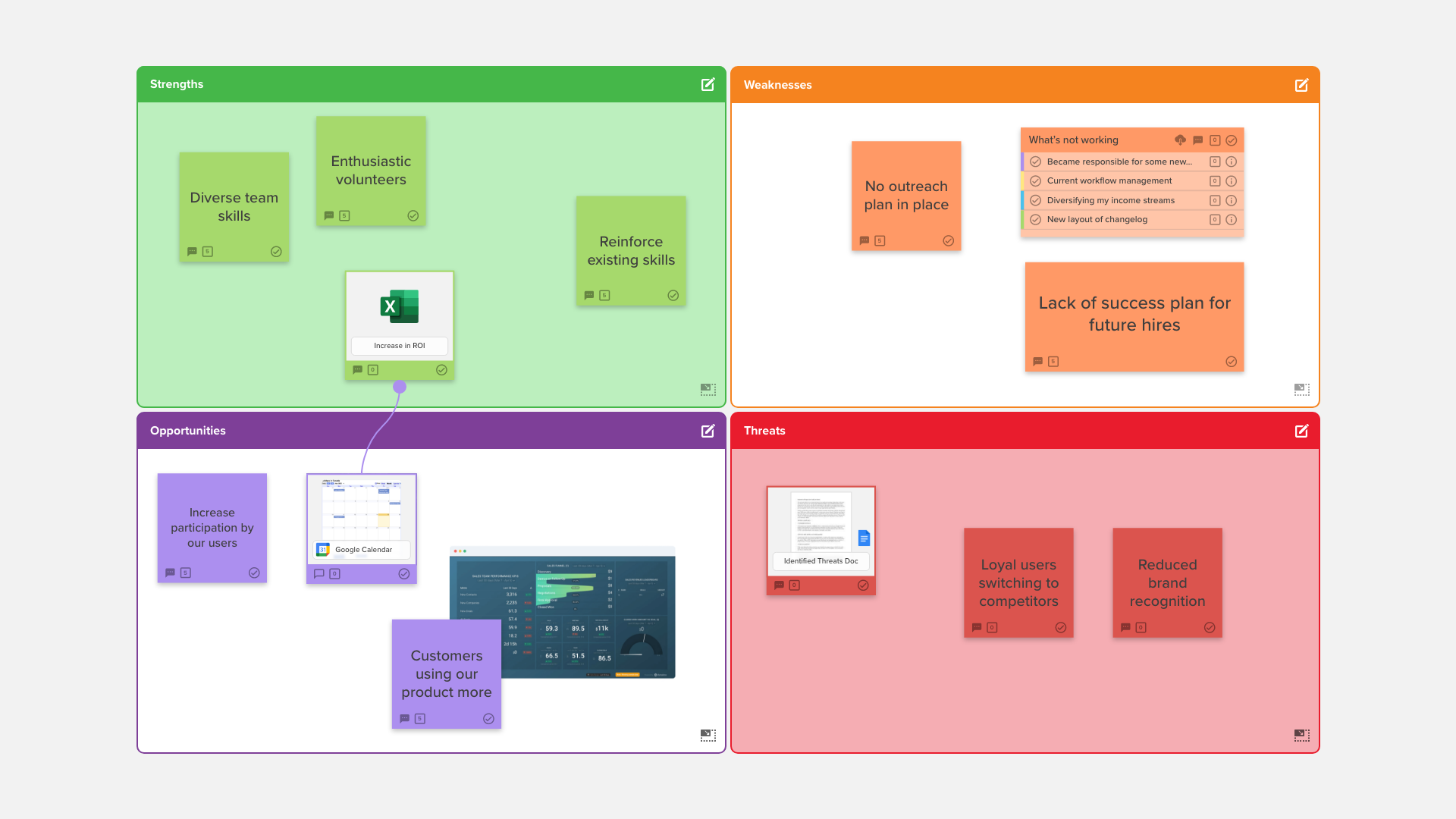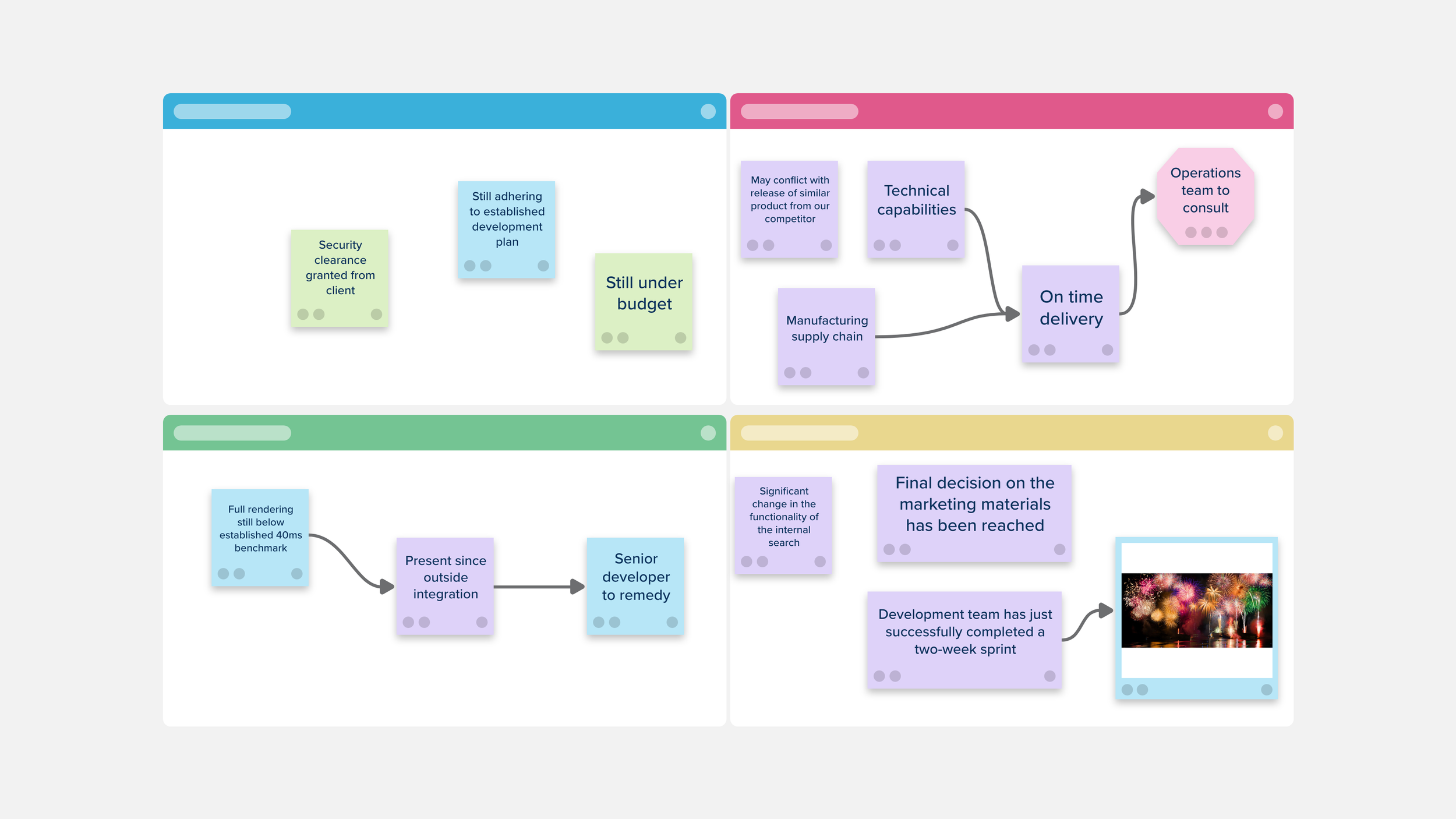Kickstart More Efficient Quarterly Planning with Stormboard
With a new year comes new plans. Managers and executives in virtually every industry have been busy reviewing results, measuring key performance indicators, and strategizing how to improve outcomes in 2023 (and beyond).
Effective Planning & Organizational Goal Setting
It’s not unusual for a business to define a high-level plan or strategy for the year — fiscal, calendar, or both — and then work with individual departments and teams to ensure alignment and tactics for executing.
Every organization, department, and team may approach their planning cycle differently, but more often than not, the common theme amongst them all is quarterly planning — or dividing the year into four distinct 3-month segments.
These quarters are where the details start to emerge and teams will look at the specific targets, metrics, and tactics that they want to focus on for a certain period.
While defining business goals and setting up a corporate plan is incredibly important (and challenging) in and of itself, it’s in the weeds of quarterly planning where the true strategy comes together.
Even if your organization’s overall strategy is largely unchanged year-over-year, there is still value in periodic reviews to make sure your team is aligned to the goals of the business.
With 2023 on the horizon, this article will define a few key items that should be considered in every quarterly plan, along with a strategy on how to make your plans more concise, contextual, and all-around more effective
What Should be Included in a Quarterly Plan?
This is the big question — what should be included, and what belongs in the annual (or weekly) planner? Our friends over at Databox suggest that quarterly plans can be broken down into 6 key elements:
Your business will likely weigh these components differently (or come up with a set of your own) depending on your own goals, metrics, and values — perhaps you want to emphasize timelines and project owners over last quarter’s review — but regardless what your approach is, your plan needs to include 3 major elements:
Goals
What you want to accomplish.
These could be anything from sales volume and margins to web design projects and product update releases. The important piece here is to ensure that whatever the goals of your team or department are, they align to — and positively influence — the overall business strategy.
Initiatives
How you’re going to do it.
Your initiatives are your strategies, tactics, and execution plans. These will vary dramatically across departments, teams, and even individuals — which makes efficient planning all the more important.
A sales representative may plan on hitting financial targets by implementing an account-based growth approach to existing customers, whereas a marketing manager may wish to improve an organization’s visibility by increasing online presence through more social media engagement.
The key to planning initiatives is to make sure they the can actually help you reach your goals — without getting too watered down by details.
The quarterly plan doesn’t necessarily need to list out all 2,867 invoices Brenda in accounting plans to send over the next 3 months — just solidify that email outreach is part of the plan.
Measure of Success
How will you know when it’s done — and if it’s done well.
The usefulness of your quarterly plan hinges on whether or not you can prove progress (or identify roadblocks). Executives and stakeholders still don’t need to know about Brenda’s never-ending list of emails, but they might want to know what the email campaign’s open rate was, and if the desired goal was met.
Setting key performance indicators, milestones, and quantitatively measurable goals for each of your different initiatives can be one of the more challenging aspects of quarterly planning, but as the saying goes, “if you can’t measure it, you can’t manage it.”
Collaborative Planning with Stormboard
In order for a quarterly plan to be effective, there needs to be alignment. Not just alignment to the organization’s overall plan, but also across departments and even within teams — regardless of size or scope.
Clear visibility into how other departments are aiming to achieve corporate goals can help teams plan around dependencies, schedule efforts, and maximize results. Even at the individual team level, simply knowing what your colleagues are working on and how it pertains to the plan can help boost cohesion and potentially help offset overloading any one person.
Stormboard is an ideal tool for planning session because it enables teams to co-create a plan asynchronously, adding and editing as ideas and plans evolve.
When it comes to aligning across departments, a planning workspace (or Storm, as we like to call it) can easily be shared with other teams, managers, executives, or stakeholders — either as a live, editable draft, or summed up cleanly in a ready-made report.
Quarterly Planning Template
All this information is great to know, but doesn’t really help with the most important part: actually building a plan.
That’s where Stormboard comes in. There are hundreds, if not thousands of “templates” out there designed so you can fill in the blanks and hand over your homework to stakeholders and call your planning done, but often, you may find that the templates available to you are for a specific department, role, industry, or just don’t make sense for what you’re trying to do.
Instead of fighting with a locked quarterly planning CSV template that another company let you download, Stormboard recommends taking a more bespoke approach.
Leverage the power of a template (i.e., the boring formatting stuff) with the flexibility of a whiteboard, calendar, and sticky note rolled up into one.
Our top templates for quarterly planning can get you and your team up and running in minutes with a workspace tailored to your specific needs.
To get started, you can use one of our calendar-based templates:
Annual, Quarterly, Monthly Overview (guide included)
All of these templates can be customized to fit the periods you are working in, whether your quarters fall neatly onto a calendar year or are staggered to fit your organization’s fiscal profile.
Quickly adjust section sizes and headings to suit your team’s unique planning method and requirements — and use it year-after-year to keep a consistent planning cycle and method that works for you.
Bottom Line
While there are plenty of best practices, recommendations, and pre-made templates out there to help you accomplish your planning, very few are going to neatly fit your team’s needs.
Just as your business goals will be unique, so too should be your planner. Get started today by choosing a Stormboard template on your free personal account, or harness the power of collaboration and get your whole team started with a free 30-day trial.
Our enterprise experts are also always available to help show you around, get you set up, or work with you to ensure your planning, financials, and proprietary ideas are protected in the a secure virtual collaboration environment trusted by governments and enterprise businesses worldwide.











